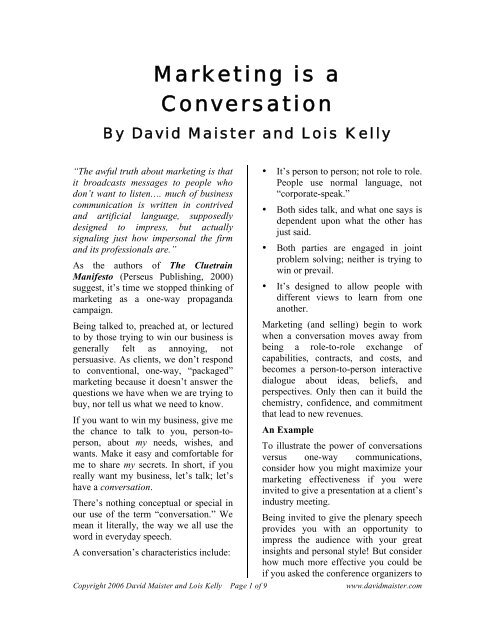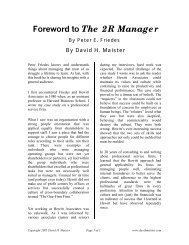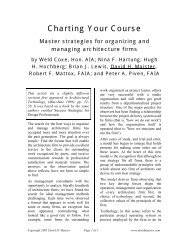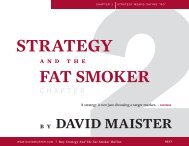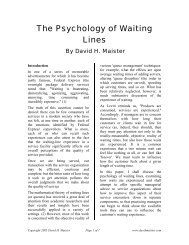pdf version - David Maister
pdf version - David Maister
pdf version - David Maister
You also want an ePaper? Increase the reach of your titles
YUMPU automatically turns print PDFs into web optimized ePapers that Google loves.
Marketing is a<br />
Conversation<br />
By <strong>David</strong> <strong>Maister</strong> and Lois Kelly<br />
“The awful truth about marketing is that<br />
it broadcasts messages to people who<br />
don’t want to listen…. much of business<br />
communication is written in contrived<br />
and artificial language, supposedly<br />
designed to impress, but actually<br />
signaling just how impersonal the firm<br />
and its professionals are.”<br />
As the authors of The Cluetrain<br />
Manifesto (Perseus Publishing, 2000)<br />
suggest, it’s time we stopped thinking of<br />
marketing as a one-way propaganda<br />
campaign.<br />
Being talked to, preached at, or lectured<br />
to by those trying to win our business is<br />
generally felt as annoying, not<br />
persuasive. As clients, we don’t respond<br />
to conventional, one-way, “packaged”<br />
marketing because it doesn’t answer the<br />
questions we have when we are trying to<br />
buy, nor tell us what we need to know.<br />
If you want to win my business, give me<br />
the chance to talk to you, person-toperson,<br />
about my needs, wishes, and<br />
wants. Make it easy and comfortable for<br />
me to share my secrets. In short, if you<br />
really want my business, let’s talk; let’s<br />
have a conversation.<br />
There’s nothing conceptual or special in<br />
our use of the term “conversation.” We<br />
mean it literally, the way we all use the<br />
word in everyday speech.<br />
A conversation’s characteristics include:<br />
• It’s person to person; not role to role.<br />
People use normal language, not<br />
“corporate-speak.”<br />
• Both sides talk, and what one says is<br />
dependent upon what the other has<br />
just said.<br />
• Both parties are engaged in joint<br />
problem solving; neither is trying to<br />
win or prevail.<br />
• It’s designed to allow people with<br />
different views to learn from one<br />
another.<br />
Marketing (and selling) begin to work<br />
when a conversation moves away from<br />
being a role-to-role exchange of<br />
capabilities, contracts, and costs, and<br />
becomes a person-to-person interactive<br />
dialogue about ideas, beliefs, and<br />
perspectives. Only then can it build the<br />
chemistry, confidence, and commitment<br />
that lead to new revenues.<br />
An Example<br />
To illustrate the power of conversations<br />
versus one-way communications,<br />
consider how you might maximize your<br />
marketing effectiveness if you were<br />
invited to give a presentation at a client’s<br />
industry meeting.<br />
Being invited to give the plenary speech<br />
provides you with an opportunity to<br />
impress the audience with your great<br />
insights and personal style! But consider<br />
how much more effective you could be<br />
if you asked the conference organizers to<br />
Copyright 2006 <strong>David</strong> <strong>Maister</strong> and Lois Kelly Page 1 of 9 www.davidmaister.com
Marketing is a Conversation<br />
let you also run a breakout discussion<br />
session, in competition with other<br />
simultaneous sessions, later in the day.<br />
Here are some of the reasons why the<br />
small-group conversation would be the<br />
superior marketing activity:<br />
• You get to talk to someone who, by<br />
choosing to participate, is admitting<br />
that he or she has a need (and you<br />
don’t waste time or money on people<br />
who haven’t).<br />
• You can now not only naturally<br />
share your thoughts but also get<br />
these potential clients to tell you how<br />
they see the issue you discussed and<br />
how it relates to them and their<br />
firms.<br />
• You can better tailor your comments<br />
to their questions and needs rather<br />
than, as in the plenary speech, guess<br />
which topics might have the broadest<br />
appeal.<br />
• You have a chance to discover what<br />
your client thinks are his or her most<br />
troublesome issues.<br />
• You can let your potential buyer<br />
meet, understand, and get<br />
comfortable with the individual who<br />
will serve him or her.<br />
• It provides both a reason and<br />
permission for you to make a followup<br />
call (“I’ve thought some more<br />
about the issues you raised last week<br />
and have put some ideas together.<br />
May I come by and share them with<br />
you?”).<br />
Both the one-way speech and the smallgroup<br />
discussion can be parts of your<br />
marketing package. But while it<br />
sometimes feels that being the featured<br />
speaker is high-impact, the truth is that<br />
you usually earn a higher return on your<br />
time by engaging in a real dialogue with<br />
people who have chosen to talk with<br />
you.<br />
In professional services, the measure of<br />
marketing effectiveness is not the<br />
number of people who hear your<br />
message but rather how effectively and<br />
quickly you can get a client to share his<br />
or her problems with you.<br />
This applies equally to both prospects<br />
and existing clients. Despite firms<br />
throwing around terms such as<br />
‘customer relationship management’ and<br />
‘cross-selling,’ there is no more certain<br />
way to deepen an existing business<br />
relationship (and generate additional<br />
business) than by having regular,<br />
ongoing conversations with your clients,<br />
person-to-person, about the things going<br />
on in their business and how you might<br />
help them address any emerging threats<br />
and/or opportunities.<br />
Note the eternal paradox: the less you try<br />
to sell in any one of these ongoing<br />
conversations, the more comfortable<br />
your clients are likely to feel about<br />
sharing their concerns, issues, and<br />
needs—and hence the more likely it is<br />
that you will attract added revenue.<br />
Turning traditional marketing<br />
approaches into conversations<br />
In stressing the need to create<br />
conversations to improve your marketing<br />
effectiveness, we do not mean to imply<br />
that all traditional marketing approaches<br />
should be discarded. Rather, they need to<br />
be restructured into conversational<br />
activities. Here are some ideas that<br />
work:<br />
1. Instead of commissioning market<br />
research, hold a “salon” with a small<br />
group of clients.<br />
People are increasingly numbed and<br />
inured to the various forms of data<br />
Copyright 2006 <strong>David</strong> <strong>Maister</strong> and Lois Kelly Page 2 of 9 www.davidmaister.com
Marketing is a Conversation<br />
collection used in market research.<br />
When was the last time you filled out the<br />
hotel’s “please tell us how we are doing”<br />
form, or agreed to participate in the<br />
market research company’s late-evening<br />
unsolicited telephone survey?<br />
Why don’t you make it more personal<br />
and real by inviting some people whom<br />
you really like and admire to come and<br />
discuss important issues of mutual<br />
interest? Be sure to invite interesting<br />
people, not just those from your biggest<br />
and most profitable accounts.<br />
A number of consulting and accounting<br />
firms discovered long ago that to make a<br />
seminar effective, it wasn’t necessary or<br />
even desirable for firm members to “hog<br />
the podium” and make all the<br />
presentations.<br />
The mere fact of organizing and running<br />
regular get-togethers for clients and<br />
prospects allowed the firm to learn what<br />
was on clients’ minds and, not<br />
coincidentally, demonstrate that the<br />
firm’s people were in the flow of what<br />
people in the client’s industry were<br />
thinking. That’s what hosting a “salon”<br />
is all about.<br />
You can kick things off by posing a<br />
what-if question that challenges a key<br />
assumption, and let the conversation<br />
unfold. You will intervene with a prompt<br />
only when the attendees can’t think of<br />
the next thing to talk about.<br />
To promote real discussion, ban<br />
presentations. Instead, use themes that<br />
center around “Why?” and “Why Not?”<br />
questions; and debate new ways of<br />
understanding client issues.<br />
Then you can wrap up by asking your<br />
clients if they think your firm should<br />
spend time around one or more of the<br />
ideas that emerged. Ask whether that<br />
would be of value to them.<br />
Meetings do not have to be in person.<br />
You could make your top professionals<br />
available for live “call-in” sessions for<br />
interested clients, so that they can “Ask<br />
the Experts.” Then, you could record<br />
each session and offer them as podcasts<br />
or as rebroadcast programs from your<br />
website.<br />
One of our clients does this superbly: a<br />
group of their clients meets monthly by<br />
phone around lunchtime, so they can eat<br />
sandwiches at their own desks while still<br />
participating in a 45-minute conversation<br />
moderated by an advisor from the firm.<br />
Clients describe it as unobtrusive,<br />
personal, effective, and free – and as a<br />
solid means of winning their business<br />
and earning their loyalty.<br />
2. Instead of focus groups, satisfaction,<br />
and other qualitative research, create<br />
private online communities for clients.<br />
The salon concept can be extended to<br />
cyberspace. Today’s on-line technology<br />
not only facilitates this old idea but<br />
perhaps even requires it.<br />
The Internet, including blogs, chat<br />
rooms, and forums, has changed how<br />
people get ideas, share information,<br />
communicate in a human voice, ask<br />
questions, and respond. Its two-way<br />
style has been embraced, changing how<br />
people want to learn, connect, and build<br />
relationships. Conversations, once key,<br />
are now crucial.<br />
Hosting and moderating such a private<br />
online community site (or forum) allows<br />
clients (and possibly prospects) to pose<br />
questions to peers, to provide input on<br />
developing industry issues and, yes, to<br />
comment on your new or enhanced<br />
services. Clients will be able to find new<br />
ideas not only from you, but also from<br />
their peers.<br />
Copyright 2006 <strong>David</strong> <strong>Maister</strong> and Lois Kelly Page 3 of 9 www.davidmaister.com
Marketing is a Conversation<br />
If someone is going to provide the place<br />
for people to chat on-line about the<br />
issues your firm serves, shouldn’t it be<br />
your firm?<br />
3. Instead of developing a capabilities<br />
brochure (including making your<br />
website an electronic brochure), turn<br />
your website into an interactive location<br />
offering advice, ideas, and commentary<br />
on trends.<br />
The Internet offers many ways to invite<br />
visitors to your site to interact and<br />
participate. You can, for example, use<br />
“how valuable was this” buttons to get<br />
people to tell you what types and<br />
formats of information are most useful to<br />
both clients and prospects.<br />
You can get visitors, viewers, and<br />
listeners to suggest topics for future<br />
content. You can use interactivity to find<br />
out which means of communication each<br />
client prefers: video, audio, or the<br />
written word, and let them select their<br />
preference. You can help each individual<br />
client experience your people and their<br />
thinking in the manner that they prefer,<br />
instead of treating all clients as an<br />
undifferentiated part of a mass audience.<br />
4. Instead of a newsletter, create and<br />
maintain a blog (a regular journal<br />
posted on the web), sharing your ideas<br />
on topics relating to your clients’<br />
sectors.<br />
Blogging forces you (for better or for<br />
worse) to think about your ideas, beliefs,<br />
and opinions, and how they are relevant<br />
to your marketplace.<br />
Critical to a blog’s success is a feature<br />
that not only allows but encourages<br />
people to post replies. Reply to the<br />
repliers. Analyze what topics are being<br />
read the most. Pay attention to data<br />
about where you’re drawing people<br />
from, and factor that into your marketing<br />
planning.<br />
It’s really hard to sustain a conversation,<br />
especially on a blog, when you don’t<br />
have anything interesting to say. Should<br />
you find you are getting stuck and are<br />
groping for something to write, it may be<br />
a signal that you, individually or as a<br />
firm, have a lot less to contribute than<br />
you thought.<br />
And if your clients don’t find what you<br />
are saying to be interesting, your<br />
problem is more than a marketing<br />
challenge!<br />
5. Instead of having a set of slides for<br />
sales presentation talking about your<br />
capabilities or your philosophies, talk<br />
about things that people like to listen<br />
to: stories!<br />
Stories help you make meaning and<br />
decipher complexity. They present<br />
points in a way that allows the listener to<br />
accept their truth without ego or<br />
ownership getting in the way.<br />
They are memorable and repeatable,<br />
thereby helping employees and clients<br />
tell others about your firm.<br />
They are the soul of conversational<br />
marketing. “Here’s a story that’s<br />
interesting…”<br />
Anytime you can get the other person to<br />
say “…and then what happened?” you<br />
will be making great progress in<br />
connections, relationships, and creating<br />
the desire in that person to talk with you<br />
more and to work with you. You need to<br />
be ready to not only describe key<br />
principles, but also to give interesting<br />
anecdotes that illustrate your ability to<br />
offer innovative ideas and solutions.<br />
But don’t keep it just one way. Make it<br />
easy for clients to tell you their stories.<br />
You’ll learn a great deal about what<br />
Copyright 2006 <strong>David</strong> <strong>Maister</strong> and Lois Kelly Page 4 of 9 www.davidmaister.com
Marketing is a Conversation<br />
needs they have, what issues they are<br />
prepared to tackle, what past experiences<br />
they have had with others in your<br />
profession, and even what new projects<br />
they are prepared to launch and pay for.<br />
6. Find ways to see the client’s<br />
perspective of what you are<br />
communicating.<br />
By definition, we professionals, when<br />
we write or speak, are doing so for<br />
clients who are not necessarily trained in<br />
our field. We must write for the<br />
intelligent layperson, communicating our<br />
expertise clearly without condescension.<br />
One rule that works effectively for us is<br />
that no article (or any document of any<br />
length) leaves the office until both one’s<br />
spouse and one’s secretary have read it,<br />
said it makes sense, and that it flows<br />
reasonably well. Both “checkers” are<br />
intelligent laypersons with no formal<br />
business training; yet they prove exactly<br />
the right audience to test our language,<br />
tone, and sense.<br />
How else are you going to make sure<br />
that what you say and intend to<br />
communicate is truly being heard as you<br />
wish it to be? Writing (or speaking) to be<br />
easily understood, and not just to<br />
impress, is a skill that can take a great<br />
deal of conscious effort to develop.<br />
7. Instead of developing presentations<br />
and proposals, conduct sales and<br />
proposal meetings as “joint problem<br />
definition and option generating”<br />
sessions.<br />
When you force clients to sit through<br />
pre-packaged presentations, you often<br />
create dynamics destructive to the<br />
chances of establishing connections that<br />
win business. Formal, prepared<br />
presentations force clients into passive<br />
listening roles, and make presenters<br />
appear pompous and more concerned<br />
about talking about themselves than<br />
about helping the client.<br />
If you doubt this, think back to the last<br />
time you had to sit through a PowerPoint<br />
presentation. How engaged were you?<br />
Most of us sit through such<br />
presentations, patiently or impatiently,<br />
silently asking ourselves, “When is this<br />
person going to shut up, so that I can ask<br />
about the real issues on my mind?”<br />
So, what should you do? Simple. Start a<br />
conversation. Sit down at eye-level with<br />
your client or prospect, and say: “I’ve<br />
brought along all the materials and<br />
information you suggested—it’s in this<br />
set of handouts I’m giving you now—<br />
but rather than my starting talking,<br />
perhaps I can ask what it is that you’d<br />
most like to find out in this meeting?”<br />
You’ll waste less time, and your clients<br />
will be grateful that you are treating<br />
them with respect. And you’ll win more<br />
business by getting quickly to the issues<br />
on their minds.<br />
This analysis can be taken further. As<br />
<strong>David</strong> pointed out in “Negotiating<br />
Quality,” a chapter in True<br />
Professionalism (Free Press, 1997), you<br />
can’t really write a proposal until you<br />
find out which <strong>version</strong> of success a<br />
client wants with this project. Does the<br />
client want the <strong>version</strong> with the least upfront<br />
cost, or the biggest long-run<br />
impact? The quickest impact, or the one<br />
that requires the least involvement by<br />
their people? Any of these are valid<br />
client requirements, but you can’t write a<br />
proposal until you have had an in-depth<br />
conversation about the alternatives.<br />
Saying “Here’s our firm’s approach” is a<br />
gamble at best, and most likely suicidal.<br />
Proposals should be developed and<br />
written together with the client as a joint<br />
activity.<br />
Copyright 2006 <strong>David</strong> <strong>Maister</strong> and Lois Kelly Page 5 of 9 www.davidmaister.com
Marketing is a Conversation<br />
8. Instead of worrying about your logos<br />
and the appearance of your written<br />
materials, pay attention to your<br />
physical space ensuring that it is<br />
designed to encourage true<br />
conversation.<br />
For example, you can take the tables out<br />
of some of your conference rooms. You<br />
can turn one wall into a white board on<br />
which participants can write as ideas<br />
emerge. You can make another wall a<br />
cork board for sticky notes so that ideas<br />
can be attached as conversations unfold.<br />
If you want clients to engage, create an<br />
environment that facilitates this!<br />
9. Instead of spending their time<br />
planning and strategizing, get your<br />
firm’s leaders to conduct a series of key<br />
“royalty to royalty” meetings outside of<br />
formal presentations.<br />
Clients are skeptical about powerful<br />
CEOs or managing partners who show<br />
up for key sales presentations or “beauty<br />
parades,” never to be heard from or seen<br />
again. It’s an old idea, but still an<br />
underutilized one: use your senior<br />
officers to have meetings with senior<br />
client officers, talking to each other<br />
about issues in a way that the mere<br />
mortals serving clients day-to-day may<br />
not be able to do. The goal of good<br />
marketing is not only to create more<br />
conversations. It is to create more kinds<br />
of conversations that will lead to new<br />
insights, stronger relationships and better<br />
ways of working together.<br />
Some guidelines for creating and<br />
conducting effective conversations<br />
So far, we have discussed some of the<br />
opportunities that professionals and their<br />
firms have to create conversations. Now<br />
let’s turn to the topic of how you ensure<br />
that you are skilled, engaging<br />
conversationalists in all of your<br />
marketing activities.<br />
Think of a dinner party conversation.<br />
What makes a good conversationalist at<br />
a dinner party? He or she:<br />
• Has a fresh point of view, but does<br />
not try to thrust it upon everyone else<br />
• Speaks politely and respectfully<br />
• Tells good stories to illustrate key<br />
points<br />
• Is good at drawing other people’s<br />
views out and drawing them into the<br />
conversation<br />
• Speaks intelligently on a variety of<br />
subjects, but is not afraid to admit<br />
areas of ignorance<br />
• Avoids trotting out well-worn<br />
arguments that have been made time<br />
and time again<br />
• Listens with genuine interest<br />
• Is light-hearted in style, but always<br />
respectful of other’s views<br />
All of these conversational skills also<br />
apply in effective marketing. You may<br />
remember to behave this way at a dinner<br />
party, but do your sales meetings really<br />
meet these criteria? What about your<br />
seminars, speeches, articles, blogs, and<br />
websites?<br />
The tone of the experience you provide<br />
clients in your marketing efforts should<br />
be friendly; it should invite people in to<br />
chat and to think about ideas; and it<br />
should encourage both sides to get to<br />
know each other as people.<br />
This, of course, requires that you are<br />
comfortable in your own skin, and that<br />
you are who you are. Much of traditional<br />
marketing is designed so that people<br />
aren’t required to put their own<br />
humanity on display. They hide behind<br />
Copyright 2006 <strong>David</strong> <strong>Maister</strong> and Lois Kelly Page 6 of 9 www.davidmaister.com
Marketing is a Conversation<br />
formal, corporate language and tactics.<br />
Not only are such approaches<br />
ineffective, but they create the<br />
impression that the professional or the<br />
firm is afraid to let its hair down.<br />
One of us (Lois Kelly) recently advised<br />
a major corporation that was reviewing<br />
its relationships with five outside PR<br />
firms. All five of the established firms<br />
explained their credentials and relevant<br />
case studies, all of which sounded<br />
remarkably the same. They all stressed<br />
how results- and client-focused they<br />
were, again sounding remarkably the<br />
same. They all asked the right questions.<br />
It was difficult to distinguish one from<br />
another. None was trying to engage the<br />
client in a dialogue. Each firm’s style<br />
was more report-like than rapport-like.<br />
The company finally called in two<br />
underdog firms that didn’t fit what they<br />
had previously thought should be the<br />
criteria for selecting an agency. Because<br />
these agencies didn’t think they had<br />
much of a chance of getting the business,<br />
they were frank, funny, provided<br />
unusual insights, challenged the<br />
company’s assumptions, and were blunt<br />
about what it would take to improve the<br />
company’s reputation.<br />
“Those guys are great,” was the<br />
overwhelming company response after<br />
the first meeting, and again through all<br />
subsequent meetings. The company<br />
hired both of the underdog agencies<br />
instead of the established firms.<br />
The traditional marketing (or sales)<br />
approach had failed miserably because it<br />
took the safe road, presenting<br />
capabilities and talking “at” the prospect<br />
rather than beginning a conversation that<br />
made the other side want to continue the<br />
dialogue.<br />
If you want to impress your prospects,<br />
you can’t afford to make arguments and<br />
points that are commonly made. You<br />
must have a fresh point of view – and<br />
it’s rarely effective if it’s just another<br />
claim about you, your firm, or “your<br />
philosophy.”<br />
Summary<br />
In discussing these thoughts with our<br />
clients, we often hear the view expressed<br />
that “This all sounds nice, but we are<br />
often only given a small amount of a<br />
client’s (or prospect’s) attention. There’s<br />
no time for a real conversation.<br />
Shouldn’t we use that brief amount of<br />
time to communicate what’s special<br />
about us?”<br />
This reasoning is flawed for many<br />
reasons, most importantly because when<br />
your initial time with a client is brief, the<br />
main success goal is make the client<br />
want to have another meeting, to<br />
continue the conversation. And talking<br />
about yourself (or your ideas) is an<br />
unlikely way to make this happen.<br />
Far better to use your limited time to get<br />
the client or prospect thinking about<br />
things in a new way, and hence eager to<br />
schedule a follow-up meeting and<br />
continue the conversation. For example,<br />
why not do what a good dinner-table<br />
conversationalist would do. Offer a<br />
provocative or counterintuitive<br />
hypothesis and begin to ask: “What if we<br />
looked at this in a different way?” “That<br />
might be interesting.” “I wonder what<br />
the reaction of others might be.”<br />
The goals of initiating and deepening<br />
relationships are vastly more important<br />
than conventional marketing’s goals of<br />
“building “awareness” and generating<br />
“leads.” And nothing— nothing—builds<br />
relationships better than regular,<br />
meaningful conversations.<br />
Copyright 2006 <strong>David</strong> <strong>Maister</strong> and Lois Kelly Page 7 of 9 www.davidmaister.com
Marketing is a Conversation<br />
To have these interesting, meaningful<br />
conversations, you must have something<br />
new to say. Developing fresh points of<br />
view means reframing issues, and<br />
creating new metaphors and language to<br />
talk about them. (See the chapters on<br />
framing and envisioning in The Trusted<br />
Advisor.)<br />
However, the message itself is only the<br />
beginning of marketing. Its value exists<br />
only if it leads to a dialogue with clients:<br />
“That was interesting, tell me more!”<br />
And if your clients aren’t asking for<br />
more, then they aren’t finding value in<br />
your message. Let’s never forget: if it’s<br />
not a conversation, then it’s not effective<br />
marketing.<br />
Strategy and the Fat Smoker<br />
Young Professionals: Cultivate The<br />
Habits of Friendship<br />
Are You Abusive, Cynical or Exciting?<br />
Doing It for the Money<br />
A Great Coach in Action<br />
Geographic Expansion Strategies<br />
Management: What It Really Takes<br />
You can automatically receive <strong>David</strong>’s<br />
future articles via e-mail (at no cost) by<br />
registering on his website<br />
(www.davidmaister.com).<br />
TEL: 1-617-262-5968<br />
EMAIL: david@davidmaister.com<br />
WEBSITE: www.davidmaister.com<br />
<strong>David</strong> <strong>Maister</strong> is the author of a number<br />
of bestselling books including:<br />
Managing the Professional Service<br />
Firm, True Professionalism (1997), The<br />
Trusted Advisor (2000) (co-author),<br />
Practice What You Preach (2001), and<br />
First Among Equals: How to Manage a<br />
Group of Professionals (2002) (coauthor.)<br />
Prior to launching his (solo but<br />
global) consulting practice in 1985, he<br />
served as a professor at the Harvard<br />
Business School.<br />
OTHER RECENT ARTICLES BY<br />
DAVID, AVAILABLE AT:<br />
www.davidmaister.com<br />
Do You Really Want Relationships?<br />
Lois Kelly is a founding principal at<br />
Foghound, a communications strategy<br />
firm that helps marketing,<br />
communications, and sales organizations<br />
develop conversation themes and<br />
programs that make it easy for their<br />
executives, sales reps, and<br />
communications managers to talk about<br />
the company in ways that build interest,<br />
understanding, trust, and relationships.<br />
Her new book, Something To Talk<br />
About, will be published this fall.<br />
TEL: 1-401-333-5464<br />
MOBILE: 1-401-952-5611<br />
EMAIL: lkelly@foghound.com<br />
WEBSITE: http://www.foghound.com<br />
BLOG: http://foghound.blogspot.com<br />
Copyright 2006 <strong>David</strong> <strong>Maister</strong> and Lois Kelly Page 8 of 9 www.davidmaister.com


